Keywords
|
| photovoltaic module, dc-dc converter, V-I characteristics, maximum power point tracker. |
INTRODUCTION
|
| The rapid increase in the demand for electricity and the recent change in the environmental conditions such as global warming led to a need for a new source of energy that is cheaper and sustainable. Solar energy has offered promising results in the quest of finding the solution to the problem. |
| A MPPT (Maximum power point tracker) is an electronic DC to DC converter that optimizes the match between the solar array and the utility grid or battery bank. This converter help to convert a higher voltage DC output from solar panels down to the lower voltage needed to charge to batteries. The main application and benefits of maximum power point (MPPT) in solar power system to increase the efficiency and power of solar cells and help to enable them to be competitive solution in an increasingly energy market. |
| By operating a solar panel or array of panels without MPPT controller that can performed maximum power point tracking with lower efficiency or result in wastage of power, and which ultimately require installing more panels for some power requirement. Maximum power point controller is used in PV system to force the PV module operating at its maximum power point (MPP). In this case the PV module produces maximum power output. To overcome the disadvantages of higher initial installation costs and low energy conversion efficiency, MPPT controller used in PV system. The charge controller are connects at the output of solar panels and it compare the panels output to the battery voltage. It then figure out what is the best power that the panel can put out to charge the battery. It takes this and converts it to best voltage to get maximum amps into the battery. Most modern MPPTâÃâ¬ÃŸs are around 93-97% efficient in the conversion. The gain can vary widely depending weather, temperature, battery state of charge or load condition and other factors. We typically get a 20-45% power gain in winter and 10-15% power gain in summer. Grid connected system are more popular as the price of solar drops and electric rate go up. There is no battery only inverter available in grid ties system. The efficiency is around 94 to 97% for the MPPT conversion on those MPPT's operate at very high audio frequencies, usually in the 20-80 kHz range. The advantage of high frequency circuits is that they can be designed with very high efficiency transformers and small components. Noise isolation and suppression becomes very important. |
| MPPT's are most effective under these conditions: Winter, and/or cloudy or hazy days - when the extra power is needed the most. |
THE PHOTOVOLTAIC POWER SYSTEM
|
| The phenomenon in which, irradiated energy convert into electric energy without mechanical mechanism is called “photovoltaic phenomenon”. This phenomenon has been established based on the particle theory of irradiated energy, and any system that used this system is called photovoltaic system. Photovoltaic system mainly consist of three parts first is solar panels or module (solar irradiation energy to electric energy), second is interface part or desire power section ,to manages and induces electric energy obtained from photovoltaic system which are designed proportion to need of consumer and third one is electric load. If the conversion ratio of converter is varied by controller to constantly adjust the operating voltage of solar panel to its maximum power (Vmp ), it is being operated as a maximum power point tracker (MPPT). |
| Since life time of photovoltaic system is abuve 20 years, its technology can be used as one of the important and useful devices in utilization of renewable energies, furthermore this energy can be use to supply electricity for area which out of grid. So use of photovoltaic system is economical in distinguished distance from electric grid [ 8 ]. |
A. The PV Cell Circuit Model
|
| A solar panel cell basically is p-n semiconductor junction. When exposed to the light, DC current is generated. This generated current varies with the light irradiance. The equivalent electric circuit of solar cell can be treated as a current source which is parallel with the diode, shunt resistance . A series resistance is connected in the circuit as shown in figure 2[3] |
| The I-V characteristics of the equivalent solar cell circuit can be determined by following equations [3]. The current through diode is given by: |
 |
| assuming no series/ shunt resistance] |
| : Diode saturation current (A) |
| q: Electron charge (1.6×10-19 C) |
| K: Boltzman constant (1.38×10-23 J/K) |
| T: Cell temperature in Kelvin (K) |
| V: solar cell output voltage (V) |
| Rs: Solar cell series resistance (Ω) |
| Rsh: Solar cell shunt resistance (Ω) |
B. V-I and P-V Characteristics of the PV Cell
|
| The characteristics of PV cell explain in to two steps. First step is to plot „voltageâÃâ¬ÃŸ Vs „powerâÃâ¬ÃŸ graph of the cell. Power is calculated by multiplying voltage across the cell with corresponding current through the cell. From the plot, maximum power point is located and corresponding voltage is noted. The second step is to go to the V-I characteristics of the cell and locate the current corresponding to the voltage at maximum power point. This current is called the current at maximum power point [5, 7, 8 ]. |
| As the P-V characteristic is constantly varying by changing the irradiance and temperature, the MPP must be tracked at the changed moment to maximize the output power from the panel. Therefore, both a tracking speed and accuracy are required to the PV system [11]. |
| The characteristic curve closely and define two of the points. First one is the short circuit current Isc and the second one is the open circuit voltage Voc. Short circuit current is the current where the cell voltage is zero. Open circuit voltage is the voltage at which the cell current is zero. The point at which Imp and Vmp meet is the maximum power point. This is the point at which maximum power is available from the PV cell. If the „load lineâÃâ¬ÃŸ crosses this point precisely, then the maximum power can be transferred to this load. The value of this load resistant would be given by: |
 |
| The quality of solar system depends upon the fill factor of solar panels. To find the quality of the solar panel fill factor is used. A good panel has fill factor in the range of 0.7 to 0.8. for a bad panel it may be as low as 0.4. Factor (FF) can be calculated as follows: |
 |
| Ideally, the fill factor should be 1 or 100%. However, the actual value of FF is about 0.8 or 80%. |
C. Series And Parallel Combination Of PV Cells
|
| The solar cells may be connected in series or parallel combination to make solar panels to improved the efficiency of PV system. |
i. Cells in Series
|
| When two identical cells are connected in series, the short circuit current of the system would remain same but the open circuit voltage would be twice. If the cells are identical, we can write the following relationships |
 |
| When we connect two dissimilar cells in series, their open circuit voltages add up but the net short circuit current takes a value in between Isc1and Isc2. |
ii. Cells in parallel
|
| When we connect two identical cells in parallel. The open circuit voltage of the system would remain same as a open circuit voltage of a single cell. But the short circuit current of the system would be twice as much as of a single cell. If the cells are identical, we can write the following relationships: |
 |
| When two dissimilar cells are connected in parallel, the short circuit currents add up but the open circuit voltage lies between Voc1and Voc2, represented by Voc [5]. |
MAXIMUM POWER POINT
|
| A maximum power point (MPPT) is used for extracting the maximum power from the solar panel and transferring maximum power from the PV module to the load. A dc to dc converter which interface between load and module, serve the purpose of transferring maximum power from PV module to the load. By changing the duty cycle the load impedance as seen by the source is varied and matched at the point of the peak power with the source so as to transfer the maximum power . |
| If a battery is just attached to a solar panel, the panel is not running at the maximum power point and the battery could be seriously damaged. What we really need is a circuit that will take power from a changing source and channel that power into a fixed voltage battery. That circuit is a switching mode power supply (SMPS). The power supply can change the load to match the maximum power point by changing the duty cycle of the pulse width modulation (PWM). The PWM can be controlled by the software that determines the MPPT [9]. |
| Therefore MPPT techniques are needed to maintain the PV arrayâÃâ¬ÃŸs operating at its MPP. For this operating point, it overcomes the disadvantages of high initial installation costs and low energy conversion efficiency. To understand how MPPT works, letâÃâ¬ÃŸs first consider the operation of a conventional (non- MPPT) charge controller. When a conventional controller is charging a discharged battery, it simply connects the modules directly to the battery. This forces the modules to operate at battery voltage, typically not the ideal operating voltage at which the modules are able to produce their maximum available power. The PV Module Power/Voltage/Current graph shows the traditional Current/Voltage curve for a typical 75W module at standard test conditions of 25°C cell temperature and 1000W/m2 of insolation. This graph (fig.4) also shows PV module power delivered vs module voltage. For the example shown, the conventional controller simply connects the module to the battery and therefore forces the module to operate at 12V. By forcing the 75W module to operate at 12V the conventional controller artificially limits power production to »53W [9]. |
| MPPT is the key to optimizing the use of solar panels. The advent of inexpensive and powerful processors has enabled more solar energy applications than ever before [9]. |
DC-DC CONVERTER
|
| DC/DC converters are used in applications where an average output voltage is required, which can be higher or lower than the input voltage.The choice of the appropriate DC/DC converter for the implementation of both the MPPT system and its integration in the facility array has not been explicitly studied, despite its affecting significantly the optimum operation of the photovoltaic system. The aim of this work is to make a comparative of the photovoltaic system performance using the three basic topologies of three different DC-DC converters (Buck and Boost converter) and MPPT tracker, for that we require the study of characteristics and properties of DC/DC converters, especially as regards the input impedance that they present under certain operating conditions. So that it may be possible to make a decision on the best configuration to be used [2]. |
| Few comparisons such as voltage, current and power output for each different combination has been recorded. Multi changes in duty cycle, irradiance, temperature by keeping voltage and current as main sensed parameter. |
| Fig.6 shows the diagram of a solar panel connected to a DC/DC converter, where the resistance shown at the converterâÃâ¬ÃŸs input is represented by Ri (RL is the converterâÃâ¬ÃŸs load resistance). In relation to the photovoltaic module, the converter is its Ri value load resistance. Assuming converters without losses, the ratio of input resistance to load resistance is shown in Table 1, both for CCM and DCM. |
| The ratio of the time interval in which the switch is on (TON) to the commutation period (TC) is called duty cycle (D) of the converter. If K value is lower than or equal to another one called Kcrit, the converter will operate in DCM. Conversely, if K exceeds the value of Kcrit, the converter will operate in CCM. As observed in Table 1, the value of Kcrit is different for each type of converter. [2]. |
| The I–V curve for a given module connected to a converter. Let us take any curve point, for example A. The photovoltaic module will operate in A provided that the output voltage and current match the voltage and current of point A(VA,IA). Thus, we will call the quotient impedance of the operating point A Assume that B is the maximum power point, therefore The system will then operate at the maximum power point (MPP) provided that Ri= In general terms, a maximum power point tracking system tries to vary impedance at the photovoltaic module output (Ri) in order to take it to the value. As has been mentioned above, the I–V curve of a photovoltaic module varies according to the incidental temperature and radiation, will vary depending on how these variables do. |
A. Buck Converter
|
| This is a converter whose output voltage is smaller than the input voltage and output current is larger than the input current. The circuit diagram is shown in the following figure . |
| The conversion ratio is given by the following expression |
 |
| Where Ro is the output resistance or load resistance of the converter. We know that D varies from 0 to ∞ (0 to 1 not inf). |
| Hence Rin would vary from ∞ to Ro as D varies from 0 to 1 correspondingly. |
| The range of Rin values for buck converters as shown in the following figures: |
| Being the expressions of Rin continuous in D, for a scanning of the converterâÃâ¬ÃŸs duty cycle D 2 [0,1], Rin takes values that belong to the interval [RL,1), being RL the load resistance or Ro. If does not belong to the set of values allowed for Rin, the capture of MPP will not be possible, thus defining a „„non-capture zone for values. Fig. shows the effect graphically. The impedance at the input of a buck converter is always a version scaled by a factor greater than or equal to 1 (see Table 1) of the impedance connected to its output Ro (Ro= Rl). Therefore, the MPP capture will only be possible for values. |
B. Boost Converter
|
| This is a converter whose output voltage is larger than the input voltage and output current is smaller than the input current. The circuit diagram is shown in the following figure |
| The conversion ratio is given by the following expression: |
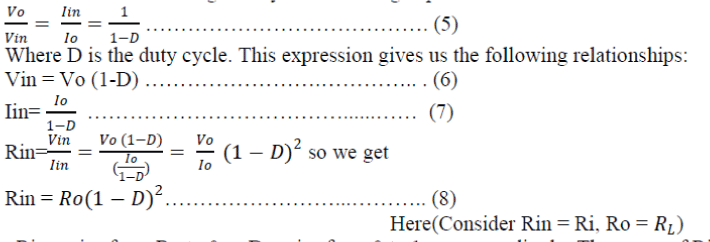 |
| Rin varies from Ro to 0 as D varies from 0 to 1 correspondingly. The range of Rin values for boost converters as shown in the following figures: |
| The maximum power point tracking system will modify the value of Rin, trying to get Rin =RMPP . However, this will not be possible if RMPP does not belong to the set of values allowed for Rin, that is, the system will not reach the MPP if . The behavior is clearly opposite to that mentioned in the previous section, and therefore there is an inversion of zones with respect to the buck converter. Fig. shows this effect. The impedance at the input of a boost converter is always a lessened version in a factor lower than or equal to 1 (see Table 1) of the impedance connected to its output (RL in our case). Therefore, the MPP capture will only be possible for Rl ≥ RMPPvalues. |
| There are two major concerns related to the efficiency of a high step-up dc–dc converter: large input current and high output voltage [7]. |
C. Buck-Boost Converter
|
| As the name indicates, this is a combination of buck converter and a boost converter. The circuit diagram is shown in the following figure: |
| Here, the output voltage can be increased or decreased with respect to the input voltage by varying the duty cycle. This is clear from the conversion ratio given by the following expression: |
 |
| Here, Rin varies from ∞ to 0 as D varies from 0 to 1 correspondingly. The range of Rin values for buck boost converters as shown in the following figures: |
| Rin is a continuous function in d, a scanning of the duty cycle, D 2 [0, 1], allows all values of Rin, i.e., Rn can take any value between 0 and 1. Consequently, the imposed restrictions for the two previous converter topologies do not affect the buck–boost converter, and therefore there is not „„non capture zoneâÃâ¬ÃŸÃ¢Ãâ¬ÃŸ. Fig. shows this effect. |
| Note that this converter allows MPP tracking in both directions [5, 3, 5]. This allows the photovoltaic solar facility to achieve the MPP regardless of the value of , thus obtaining a higher power point tracking efficiency. It is observed that when the panel is directly connected to the resistive load, without inserting any DC/DC converter, the system will only operate at the maximum power point when and match (see Fig.). If a buck converter is inserted between the panel and the load (Fig.), we can observe that the system is only able to follow the maximum power point for not very high irradiation values (depending on RL), i.e., when the maximum power point impedance is relatively high. At maximum solar irradiation hours, reaches its minimum values, and so the system is unable to achieve the MPP. This is even more evident that the higher RL is in relation to . When it is used a boost converter, (Fig), the system is able to reach the maximum power point only at maximum irradiation hours (low ), with a remarkable loss of MPP-tracking efficiency at the initial and final hours of the day. |
| Rin can take any value with this converter. This allows the photovoltaic solar system to reach the MPP regardless of the existing irradiation level and , achieving a higher MPP-tracking efficiency. Note that the MPP can be tracked for any value, regardless of its relationship with . |
| In Table 2, a comparative of the MPP-tracking efficiency provided by each of the configurations for the concerned day of study is given. Observe that in all cases, the configuration with buck–boost converter is the one that presents the highest efficiency [2]. |
| Finally, when a buck–boost converter is used the PMPP (t) and P(t) trajectories are graphically equal, with values of 0.999 for the MPP-tracking efficiency. |
CONCLUSION
|
| The buck–boost DC/DC converter topology is the only one which allows the follow-up of the PV module maximum power point regardless of temperature, irradiance and connected load and the connection of a buck–boost DC/DC converter in a photovoltaic facility to the panel output could be a good practice to improve performance. |
| The buck and boost converters are the most efficient topologies for a given price, while voltage flexibility varies. The buck–boost converters are always at efficiency but at higher price. There are already configurations of buck– boost and Cuk converters where both the MOSFET and the inductor are of a very low resistance, achieving efficiencies as regards input power higher than 95% and hardly 2 or 3% lower than the buck and boost topologies. |
| We suggest that the good practice could be including a buck- boost DC-DC converter in PV system facilities at the PV array output and then connecting ,after the converter , the rest of the load or battery banks. This practice ensures the PV panel maximum power point tracking for any solar irradiation, cell temperature and load conditions, which could rebound to the facilities higher system efficiency. |
Tables at a glance
|
 |
 |
| Table 1 |
Table 2 |
|
| |
Figures at a glance
|
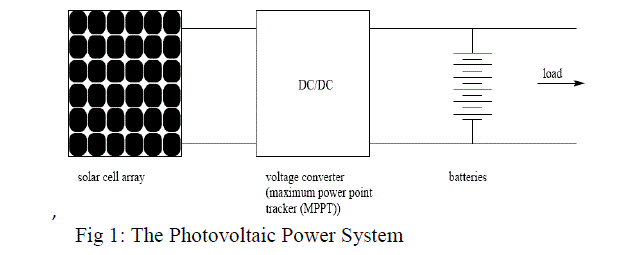 |
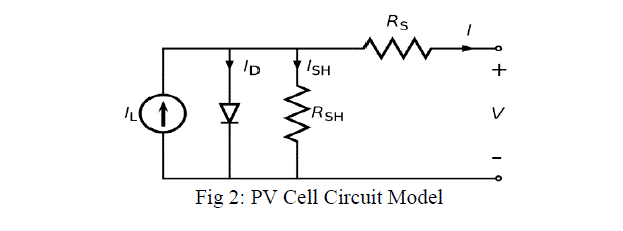 |
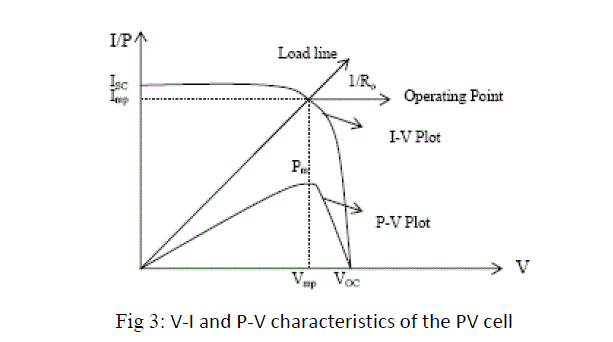 |
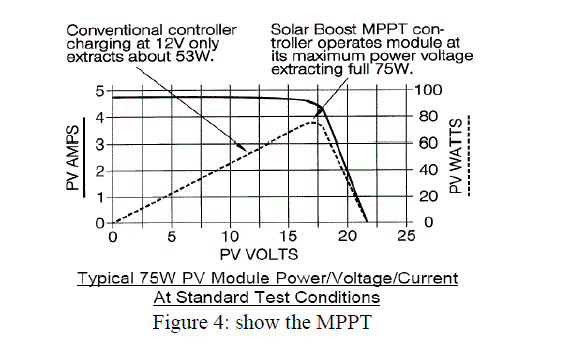 |
| Figure 1 |
Figure 2 |
Figure 3 |
Figure 4 |
|
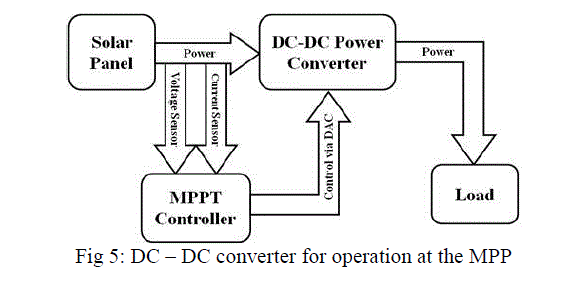 |
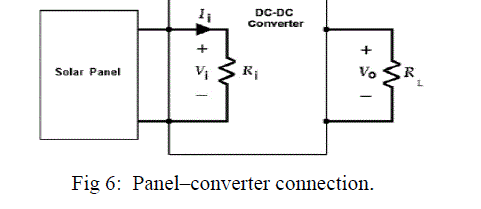 |
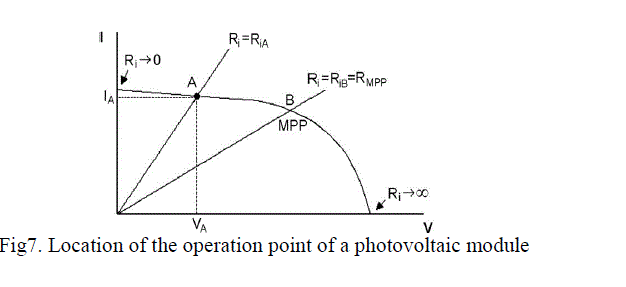 |
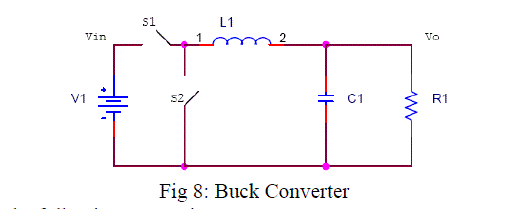 |
| Figure 5 |
Figure 6 |
Figure 7 |
Figure 8 |
|
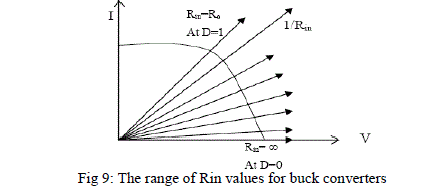 |
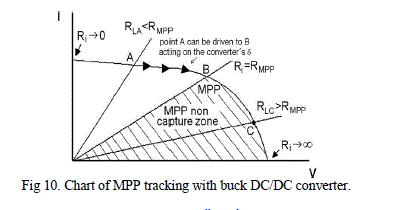 |
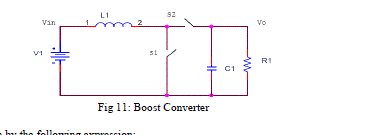 |
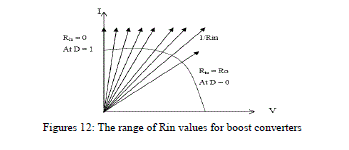 |
| Figure 9 |
Figure 10 |
Figure 11 |
Figure 12 |
|
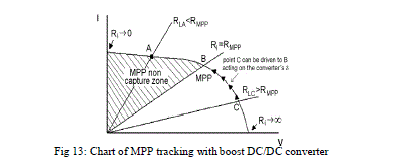 |
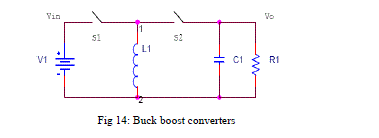 |
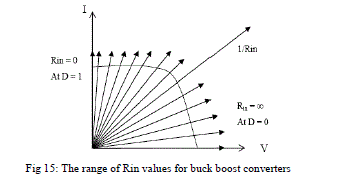 |
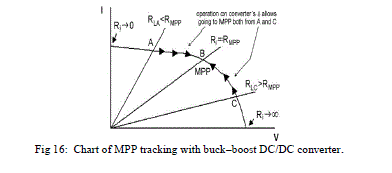 |
| Figure 13 |
Figure 14 |
Figure 15 |
Figure 16 |
|
| |
References
|
- J.M. Enrique a, E. Dura´n a, M. Sidrach-de-Cardona b,1, J.M. Andu´ jar a “Theoretical assessment of the maximum power point tracking efficiency of photovoltaic facilitieswith different converter topologies” Available online at www.sciencedirect.com Solar Energy 81 (2007) 31– 38.
- A. Pradeep Kumar Yadav1, S.Thirumaliah2, G.Haritha3” Comparison of MPPT Algorithms for DC-DC Converters Based PV Systems” International Journal of Advanced Research in Electrical, Electronics and Instrumentation Engineering Vol. 1, Issue 1, July 2012.
- L. Umanand “Learning material-Non-Conventional Energy System” online at www.nptl.com, IIsc Bangalore /April 04/3.
- S.Daison Stallon, K.Vinoth Kumar, S. Suresh Kumar” High Efficient Module Of Boost Converter In PV Module” International Journal of Electrical and Computer Engineering (IJECE) Vol.2, No.6, December 2012, pp. 758~781 ISSN: 2088-8708.
- S. B. Sadati, M. Yazdani-Asrami, M. Taghipour, and H. Vahedi “Economic Evaluation Of Supplying Rural And Residential Areas Using Photovoltaic Systems In I. R. IRAN” Journal of Electrical Engineering: Theory and Application (Vol.1-2010/Iss.3) Sadati et al. / Economic Evaluation of Supplying Rural and Residential Areas … / pp. 182-188.
- A. Freitas1, F. Antunes1, E. Mineiro2, A. Lima3, A. Gadelha1 and F. Gualter¹ “DC-DC high gainconverter applied to renewable energy with new proposed to MPPT search” International Conference On Renewable Energies And Power Quality (ICREPQâÃâ¬ÃŸ12) Santiago De Compostela (SPAIN),28th TO 30th March, 2012.
- R. Arulmurugan*, N. Suthanthira Vanitha “Optimal Design of DC to DC Boost Converter with Closed Loop Control PID Mechanism for High Voltage Photovoltaic Application” International Journal of Power Electronics and Drive System (IJPEDS) Vol.2, No.4, December 2012, pp. 434~444 ISSN: 2088-8694.
|





